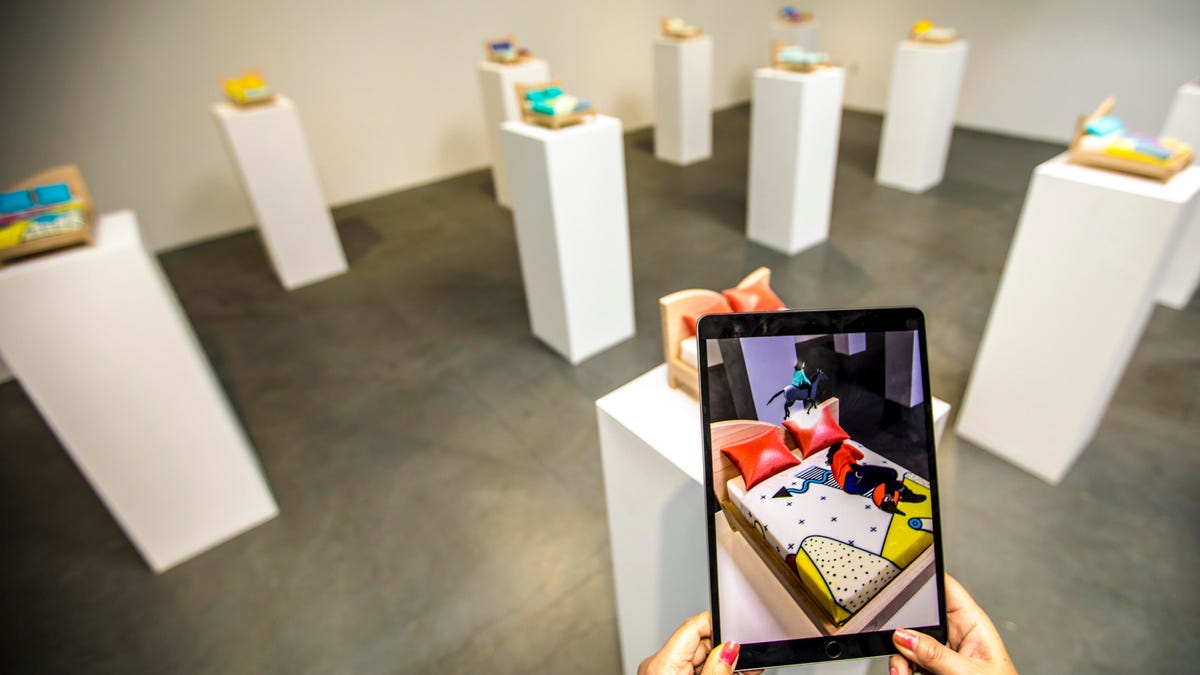Calling all artists: Time to try AR, Adobe says
A San Francisco gallery shows how augmented reality can be a new creative medium.

Miniature bed sculptures act as platforms for artist Gabriel Barcia-Colombo's friends, who have been translated to avatars. The AR animations show each pereson's dreams.
Michelangelo had sculpture. Vincent van Gogh had oil painting. Ansel Adams had film. But who's going to pioneer augmented reality ?
At the Minnesota Street Project, a gallery in San Francisco's hip and fast-developing Dogpatch district, Adobe Systems is trying to kick-start AR as a new medium for artists. Exhibits placed swirling dragons and fluttering butterflies into empty rooms, showed digitized people on miniature real-world accompanied by their animated dreams, and translated a singing opera singer into a wall-size face blasting glowing particles into space.
Augmented reality, which overlays digital imagery onto our view of the real world, could be either a techno-curiosity or the next big thing. Adobe, which announced a new AR creation tool called Aero at Apple's Worldwide Developers Conference this week, is in the next big thing camp.
"Digital technologies are going to escape our screen and become of the space all around us," Adobe Chief Technology Officer Abhay Parasnis said at a preview of a gallery called Festival of the Impossible, which opens Friday. There's a lot of AR hype now, but he thinks we're underestimating how profound the spread of AR will be in the long run.
AR and its cousin, virtual reality, once required high-end hardware, but phones are bringing it to the mass market. That opens new avenues for creative expression. Now it's up to the artists -- and the companies that supply them with tools -- to turn their creativity into something entertaining, thought-provoking and memorable.
Beware gimmicks
Maybe AR will rise to claim a place alongside the silver screen, marble and stretched canvas. But we'll probably have to endure a lot of gimmicks during the AR novelty phase.
"A lot of the new mediums have a wow factor, but to make something that's very emotional is difficult," said Gabriel Barcia-Colombo, an artist at the show.
His exhibit, "Descent: Or Do Avatars Dream of Auto-Rigged Sheep," shows a group of tiny beds. Holding an iPad in front of each shows a 3D view of one of his friends perched or lying on the bed, with an animation appearing above that represents their dreams -- being trapped in a bottle or riding a giant galloping cat.
"Robotic Voice Activated Wordkicking Machine" by Neil Mendoza translates spoken words into images on a screen that either are kicked by a real robot foot or fall into another tube to be spoken back to the viewer.
Adobe -- ever eager to supply creative people with tools like Photoshop, Premiere Pro and Illustrator -- hopes to advance the progress of AR artistry with Project Aero. "As every medium comes along, there is a period of time where the potential is obvious but the tools consume much time and become a distraction," Parasnis said. Aero is designed to ease the pain, so an AR artist doesn't need to worry about learning programming technologies like Unity or Unreal.
Even with software to ease the way, AR art still brings new technical concerns.
"It's more similar to sculpting than traditional painting," said artist Estella Tse, who's showing an AR work called "Two Sides of the Same Coin" about the duality of her Chinese-American heritage. Sculpting a 3D shape is only a first step, though. "How is someone going to walk through my installation? I think more about environmental design and user experience design," she said.
AR art with Aero
Using Aero, artists still use other software like Photoshop or Adobe Dimension to create their 3D designs, but then they use Aero to place them spatially and create an AR file in the USDZ format that Adobe is backing along with Apple and Pixar.
Adobe Chief Technology Officer Abhay Parasnis
Once the file is created, somebody with an iPhone or other compatible device can check it out. Adobe also hopes to help on the distribution side of the business by hosting AR content.
Artistry is one thing, but Adobe hopes Aero will help other customers, too. One common AR idea is for retail, where you could see a 3D model cavorting in clothes you're thinking of buying. Another idea: a repair person could see labeled parts or repair instructions in front of the equipment that needs fixing. Or a menu could present a 3D view of dishes you're perusing.
But now, Adobe is trying to get artists interested. With AR, you no longer have to travel to the Louvre, Uffizi or Met to see something.
"It's possible you could be buying artwork from the app store, not just the gallery," Barcia-Colombo said.
The Smartest Stuff: Innovators are thinking up new ways to make you, and the things around you, smarter.
Tech Culture: From film and television to social media and games, here's your place for the lighter side of tech.

